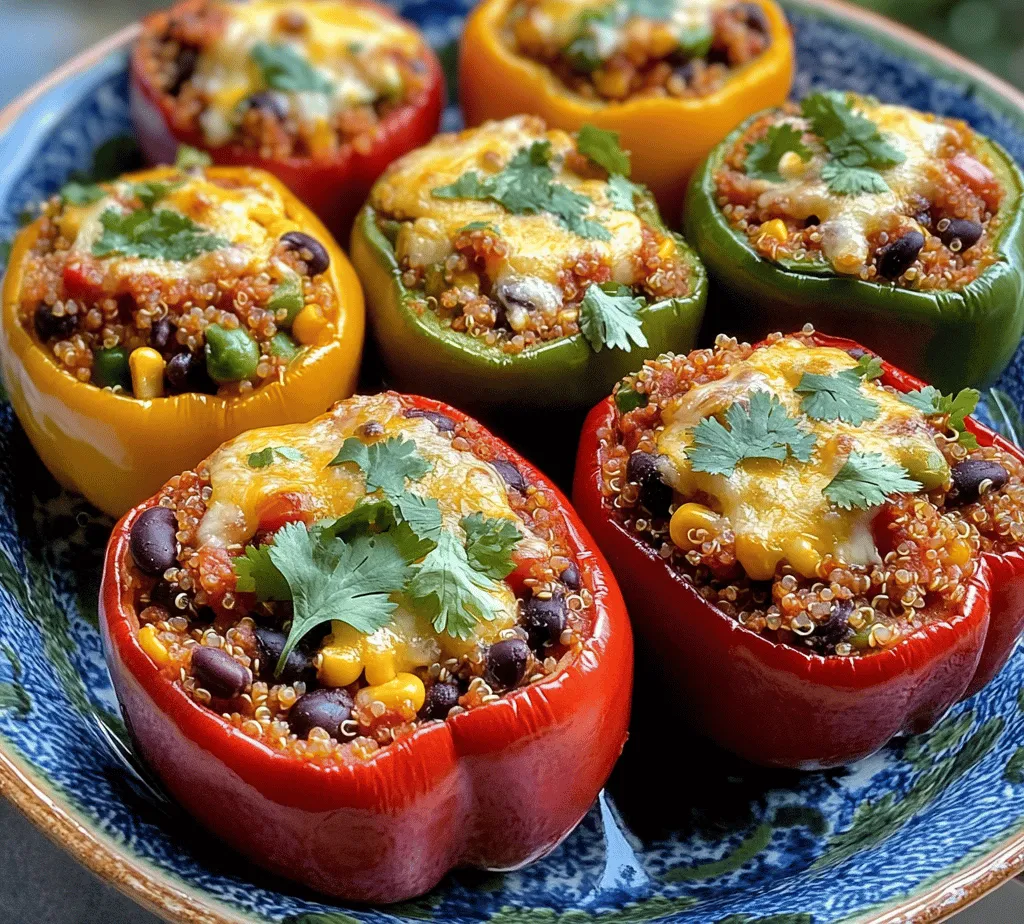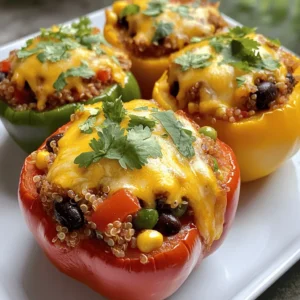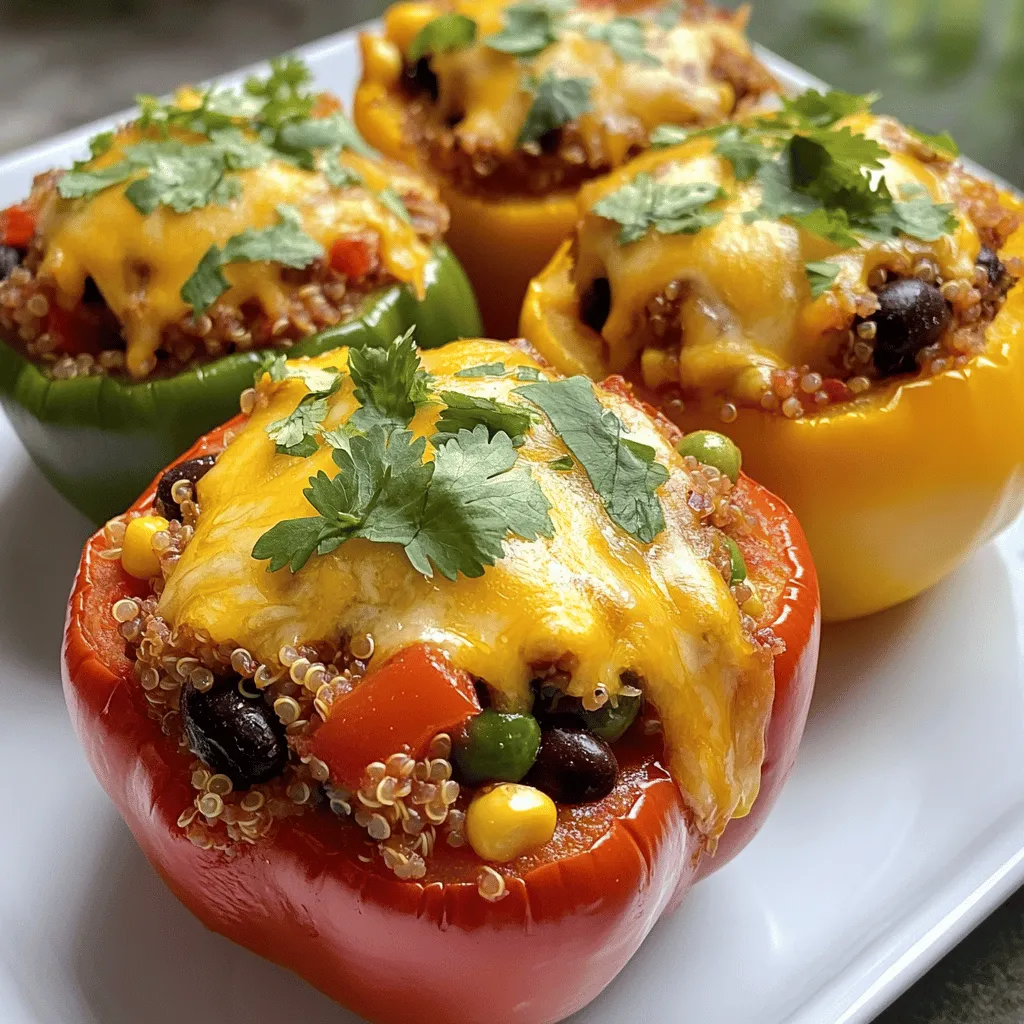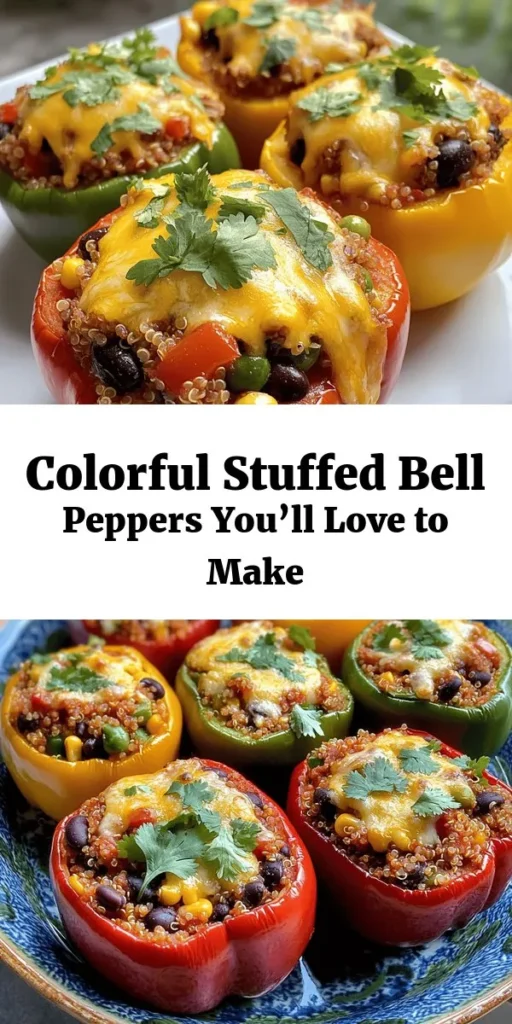Introduction
Stuffed bell peppers have become a beloved dish across kitchens worldwide, celebrated for their versatility and nutritional benefits. This vibrant meal is not only a feast for the eyes but also for the palate, offering a delightful combination of flavors and textures. With bell peppers serving as the perfect vessel, home cooks can create a variety of fillings to suit any dietary preference—from vegetarian to gluten-free, or even a hearty meat-filled option. The bright hues of bell peppers—ranging from deep red to sunny yellow and crisp green—not only make for a visually appealing presentation but also signal a wealth of vitamins and minerals packed inside.
In this recipe, we will guide you through creating Easy Stuffed Bell Peppers, a dish that is as satisfying to make as it is to eat. Whether you’re preparing a family dinner, looking for meal prep ideas, or just wanting to impress friends at a gathering, this recipe is an excellent choice. It combines wholesome ingredients, a medley of spices, and the option for customization, ensuring that it caters to various dietary needs while remaining delicious and easy to prepare.
Understanding the Ingredients
To create the perfect stuffed bell peppers, it’s essential to understand the star ingredients that make up this dish. Each component not only contributes to the overall flavor but also enhances the nutritional profile of the meal.
Bell Peppers: Colorful and Nutritious
Bell peppers are the centerpiece of this dish, providing a sweet crunch that complements the other flavors beautifully. Rich in vitamins A and C, bell peppers are known for their health benefits, including boosting the immune system and promoting healthy skin. The vibrant colors of the peppers also indicate a variety of antioxidants, making them a perfect choice for a nutrient-dense meal.
When selecting bell peppers at the grocery store, look for ones that are firm, glossy, and free from blemishes. The weight of the pepper should feel substantial for its size, indicating freshness. Each color of bell pepper has its unique flavor profile—green peppers are slightly more bitter, while red and yellow peppers are sweeter and juicier.
Quinoa vs. Rice: The Filling Debate
When it comes to the filling for your stuffed peppers, you have the option of using quinoa or rice. Both ingredients are excellent bases, but they offer different flavors, textures, and nutritional benefits.
Quinoa is a complete protein, containing all nine essential amino acids, making it an excellent choice for vegetarians and those seeking a nutritious alternative to grains. It has a slightly nutty flavor and a fluffy texture, which pairs well with various spices and vegetables.
Rice, on the other hand, is a staple in many households and provides a comforting texture that many people love. Brown rice is the healthier option, offering more fiber and nutrients compared to white rice. However, it is essential to consider cooking times, as brown rice takes longer to prepare than quinoa.
In this recipe, we recommend using quinoa for its health benefits and its ability to absorb flavors beautifully, but feel free to substitute rice if you prefer.
The Power of Black Beans and Corn
Incorporating black beans and corn into your stuffed pepper filling adds a significant protein boost along with fiber, which is essential for digestive health. Black beans are rich in iron, potassium, and antioxidants, while corn adds a touch of sweetness and crunch that complements the dish’s overall texture. Together, they create a filling that is not only hearty but also satisfying, making your stuffed peppers a complete meal.
Spices: Elevating Flavor
The magic of stuffed bell peppers lies in the spices that enhance the filling. In this recipe, we use a blend of cumin, smoked paprika, garlic powder, and onion powder to create a depth of flavor that will elevate your dish.
– Cumin adds an earthy, warm undertone that is synonymous with many comfort foods.
– Smoked paprika brings a subtle smokiness that adds complexity and enhances the dish’s overall appeal.
– Garlic powder and onion powder round out the flavors, providing a savory foundation that makes the filling irresistible.
Feel free to adjust the spice levels according to your taste preferences, or even experiment with fresh herbs to bring a new dimension to your stuffed peppers.
Cheese: A Creamy Finish
To add creaminess and richness to your stuffed peppers, cheese is an excellent topping choice. Whether opting for shredded cheddar, mozzarella, or pepper jack, the melted cheese creates a delicious crust that contrasts beautifully with the tender bell pepper. For those seeking a dairy-free option, there are numerous plant-based cheese alternatives available that melt well and deliver a similar flavor profile.
Preparation Steps in Detail
Now that you understand the ingredients involved in making stuffed bell peppers, let’s dive into the preparation steps. This section will guide you through the process of prepping the peppers, making the filling, and assembling the dish.
Prepping the Peppers
1. Selecting the Peppers: Start by choosing the bell peppers for your dish. Aim for a mix of colors to create a visually appealing array. If you’re unsure which colors to pick, a combination of red, yellow, and green will not only look beautiful but also taste great.
2. Cutting the Peppers: Begin by washing the bell peppers thoroughly under running water. Next, use a sharp knife to slice the tops off each pepper, about one inch from the stem. Alternatively, you can cut them in half lengthwise if you prefer a different presentation.
3. Cleaning the Peppers: After cutting off the tops, use a spoon to scoop out the seeds and the white membranes inside. Make sure to remove all the pith, as it can be bitter. Rinse the insides again to ensure they are clean and ready for stuffing.
4. Parboiling (Optional): For a softer texture, you can parboil the bell peppers. Bring a pot of salted water to a boil and immerse the cleaned peppers for about 5 minutes. This step is optional, but it helps ensure that the peppers are tender once baked.
Making the Filling
1. Cooking the Quinoa: If you’ve opted for quinoa, rinse it under cold water before cooking. In a medium saucepan, add one cup of quinoa and two cups of water (or vegetable broth for added flavor). Bring to a boil, then reduce heat to low, cover, and simmer for about 15 minutes, or until the quinoa is fluffy and the water is absorbed. Fluff with a fork and set aside.
2. Sautéing the Veggies: In a large skillet, heat a tablespoon of olive oil over medium heat. Add finely chopped onions and bell pepper tops (if using) and cook until softened, about 3-4 minutes. Then, add minced garlic (if using fresh) and sauté for another minute until fragrant.
3. Combining the Filling Ingredients: In a large mixing bowl, combine the cooked quinoa or rice, sautéed vegetables, black beans, corn, and your chosen spices. Mix well until the ingredients are evenly distributed. Taste and adjust seasoning as necessary.
Stuffing the Peppers
1. Filling the Peppers: Take your cleaned bell peppers and begin filling them with the quinoa mixture. Using a spoon, pack the filling tightly to ensure they are filled to the brim. This not only maximizes flavor but also prevents the filling from spilling out during baking.
2. Topping with Cheese: If you’re using cheese, sprinkle a generous amount on top of each stuffed pepper. This will create a delicious, melted layer that adds richness to the dish.
3. Preparing for Baking: Place the stuffed peppers upright in a baking dish. If they seem unstable, you can slice a small amount off the bottom of each pepper to create a flat surface, but be careful not to cut through to the filling.
By following these preparation steps, you’ll have beautifully stuffed bell peppers ready for baking. With their vibrant colors and delicious filling, these Easy Stuffed Bell Peppers are sure to be a hit at your dining table, providing a nutritious and satisfying meal for everyone to enjoy. Stay tuned for the next part of the recipe, where we will cover the baking process and additional tips for making these stuffed peppers your own.

Importance of Cheese Placement for Optimal Melting and Flavor
When it comes to crafting the perfect stuffed bell peppers, the placement and type of cheese you choose can significantly enhance both the flavor and texture of the dish. For optimal melting and flavor infusion, it’s best to layer the cheese. Start by mixing some shredded cheese, such as mozzarella or cheddar, into the filling before stuffing the peppers. This allows the cheese to meld with the other ingredients, creating a creamy and cohesive mixture. After you fill the peppers, top them with an additional layer of cheese. This not only adds a delightful cheesy crust but also helps seal in the moisture, keeping the filling tender and flavorful.
Baking Process Explained
Setting the Oven Temperature
Preheating your oven to 375°F (190°C) is crucial for achieving perfectly cooked stuffed bell peppers. This temperature allows the peppers to become tender while ensuring the filling heats through evenly. If the oven is too hot, the exterior may char while the inside remains cold; too low, and your peppers may end up soggy.
Covering with Foil vs. Baking Uncovered
Deciding whether to cover your stuffed peppers with foil can affect the final texture and moisture level. Covering the peppers with foil during the initial baking period helps trap steam, cooking the peppers faster and keeping them moist. Remove the foil during the last 10-15 minutes of baking to allow the cheese to brown and create a deliciously crisp top. Baking uncovered throughout the entire process will lead to a firmer texture, but the risk is that the filling may dry out if not monitored closely.
Importance of Timing
Timing is essential when baking stuffed bell peppers. Generally, they will need about 30-40 minutes in the oven. To determine when they are perfectly cooked, look for the peppers to be tender yet still holding their shape. The cheese should be bubbling and golden, indicating that the filling is heated through. If you’re unsure, a quick poke with a fork can help you assess tenderness.
Visual Cues to Look For
As your stuffed bell peppers bake, keep an eye on visual cues that signal doneness. The cheese should start to bubble and turn golden brown. The peppers themselves will become vibrant in color, and a slight wrinkle may form on their skin. When you can easily pierce the flesh of the pepper with a fork, it’s a good indication they are ready to come out of the oven.
Serving Suggestions
Ideas for Garnishing the Dish
Garnishing your stuffed bell peppers can elevate the dish aesthetically and enhance the overall flavor. Fresh herbs like cilantro or parsley can add a burst of color and a fresh flavor that complements the richness of the cheese and filling. A sprinkle of freshly cracked black pepper or a drizzle of balsamic glaze can also add a sophisticated touch.
Pairing Options
Stuffed bell peppers are versatile and can be served alongside a variety of side dishes. Consider pairing them with a refreshing green salad tossed in a light vinaigrette to balance the hearty filling. Quinoa salad, roasted vegetables, or even a side of garlic bread can make for a well-rounded meal. If you’re looking for something more substantial, serve them with a side of rice or couscous.
Tips for Serving
Presentation matters, especially when serving stuffed bell peppers for family meals or gatherings. Arrange the peppers on a large platter and garnish with fresh herbs for an appealing display. Consider serving them in individual bowls, drizzled with sauce or dressing for added flair. For a family-style meal, you can place the whole baking dish on the table, allowing everyone to serve themselves.
Nutritional Information
Breakdown of Nutritional Values
Stuffed bell peppers are not only delicious but also packed with nutrients. A serving typically contains approximately:
– Calories: 250-300
– Protein: 15-20g
– Fiber: 5-7g
– Vitamins: High in Vitamin C and A
– Minerals: Good source of potassium and magnesium
These values can vary based on the ingredients used, especially if you opt for lean ground meats or plant-based proteins.
Discussion on Health Benefits
Incorporating colorful vegetables like bell peppers into your diet provides numerous health benefits. They are low in calories yet rich in essential vitamins and antioxidants, which can help reduce inflammation and support overall health. The high fiber content in stuffed bell peppers promotes digestive health, while the variety of vegetables can contribute to a well-rounded nutrient intake.
Considerations for Dietary Restrictions
Stuffed bell peppers can easily accommodate various dietary restrictions. For those following a gluten-free diet, simply ensure that any added sauces or grains are gluten-free. Vegetarian and vegan options can be created by substituting meat with plant-based proteins like lentils, chickpeas, or quinoa. You can also use dairy-free cheese alternatives to cater to those with lactose intolerance.
Variations of Stuffed Bell Peppers
Exploring Different Variations
Stuffed bell peppers are incredibly versatile, allowing for endless variations based on personal preferences and cultural influences. For a classic touch, consider using a mixture of ground beef and rice seasoned with Italian herbs. Alternatively, for a vegetarian option, you can fill them with a mix of black beans, corn, and brown rice, seasoned with cumin and chili powder for a Southwestern flair.
Creative Ingredient Swaps
To keep things interesting, don’t hesitate to experiment with different ingredients. For a Mediterranean twist, try using couscous, feta cheese, and olives as a filling. For a Cajun-inspired variation, incorporate andouille sausage, rice, and Creole seasoning. You can also switch up the grains; quinoa, farro, or even cauliflower rice can work beautifully in place of traditional rice.
Seasonal Adaptations
Seasonal vegetables can be a fantastic way to enhance the filling of your stuffed peppers. In the summer, add fresh zucchini or corn, while in the fall, consider including diced butternut squash or sweet potatoes. This not only diversifies the flavors but also takes advantage of what’s fresh and available in your area.
Conclusion
Stuffed bell peppers are an easy and nutritious meal option that combines vibrant colors and flavors, making them a delightful addition to any table. Their versatility allows for customization, ensuring that there’s a version for everyone, whether meat-lover or vegetarian. The combination of nutritious ingredients packed into each pepper makes for a wholesome dish that is as appealing to the eye as it is to the palate.
Encouraging readers to experiment with their variations is an invitation to personalize this dish further. Whether you choose to stick with the classic recipe or venture into creative new territory, stuffed bell peppers can cater to your family’s tastes and dietary needs. Embrace the vibrant colors, flavors, and nutritional benefits of stuffed bell peppers, and make them a staple in your cooking repertoire.



